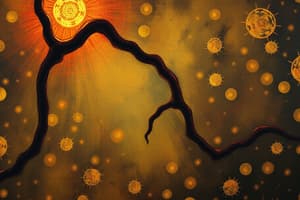Podcast
Questions and Answers
What is the primary function of ATP synthase in cellular respiration?
What is the primary function of ATP synthase in cellular respiration?
- To produce carbon dioxide during the Krebs cycle
- To break down glucose into pyruvates
- To catalyze the formation of ATP from ADP and phosphate (correct)
- To facilitate the movement of electrons in the electron transport chain
Which of the following processes occurs in the mitochondria?
Which of the following processes occurs in the mitochondria?
- Glycolysis
- Fermentation
- Conversion of G3P to pyruvate
- Electron transport chain (correct)
What is produced during the Krebs cycle for each pyruvate that is processed?
What is produced during the Krebs cycle for each pyruvate that is processed?
- 1 ATP, 3 NADH, and 2 FADH2
- 3 ATP, 1 NADH, and 1 FADH2
- 2 ATP, 3 NADH, and 1 FADH2 (correct)
- 2 ATP, 1 NADH, and 3 FADH2
During which phase of cellular respiration is the majority of ATP generated?
During which phase of cellular respiration is the majority of ATP generated?
Which statement about anaerobic respiration is true?
Which statement about anaerobic respiration is true?
What is the primary role of NAD+ in cellular respiration?
What is the primary role of NAD+ in cellular respiration?
In glycolysis, how many ATP molecules are generated in total?
In glycolysis, how many ATP molecules are generated in total?
During the citric acid cycle, what are the primary products formed from one cycle of pyruvic acid?
During the citric acid cycle, what are the primary products formed from one cycle of pyruvic acid?
What process occurs in the mitochondria after glycolysis?
What process occurs in the mitochondria after glycolysis?
What is the function of FAD in cellular respiration?
What is the function of FAD in cellular respiration?
What is generated as electrons are passed through the electron transport chain?
What is generated as electrons are passed through the electron transport chain?
Where does glycolysis occur within a eukaryotic cell?
Where does glycolysis occur within a eukaryotic cell?
What is a significant contribution of NADH produced during glycolysis?
What is a significant contribution of NADH produced during glycolysis?
Flashcards
Glycolysis
Glycolysis
A key process in cellular respiration where glucose is broken down into two pyruvate molecules. It occurs in the cytoplasm and yields a net gain of 2 ATP molecules.
Mitochondria
Mitochondria
The powerhouse of the cell where cellular respiration takes place.
Aerobic Respiration
Aerobic Respiration
This process utilizes oxygen to generate substantial ATP. It occurs in the mitochondria and involves the electron transport chain.
Anaerobic Respiration (Fermentation)
Anaerobic Respiration (Fermentation)
Signup and view all the flashcards
Krebs Cycle (Citric Acid Cycle)
Krebs Cycle (Citric Acid Cycle)
Signup and view all the flashcards
NAD+/NADH
NAD+/NADH
Signup and view all the flashcards
FAD/FADH2
FAD/FADH2
Signup and view all the flashcards
Pyruvate Oxidation
Pyruvate Oxidation
Signup and view all the flashcards
Citric Acid Cycle (Krebs Cycle)
Citric Acid Cycle (Krebs Cycle)
Signup and view all the flashcards
Electron Transport Chain
Electron Transport Chain
Signup and view all the flashcards
Oxidative Phosphorylation
Oxidative Phosphorylation
Signup and view all the flashcards
Cellular Respiration
Cellular Respiration
Signup and view all the flashcards
Study Notes
Cellular Respiration Overview
- Cellular respiration is the process of breaking down glucose to produce ATP (energy).
- Aerobic respiration requires oxygen, producing 30-38 ATP molecules per glucose molecule.
- Anaerobic respiration (fermentation) occurs without oxygen, only glycolysis occurs producing a low amount of ATP (2 ATP).
Stages of Cellular Respiration
- Glycolysis: Occurs in the cytoplasm, glucose is broken down into 2 pyruvate molecules. Produces 2 ATP, 2 NADH, occurs in both aerobic and anaerobic respiration.
- Pyruvate Oxidation (Preparatory Reaction): Occurs in the mitochondrial matrix, pyruvate is converted to Acetyl CoA. Produces 2 NADH and releases CO2.
- Citric Acid Cycle (Krebs Cycle): Occurs in the mitochondrial matrix, acetyl CoA enters the cycle, releasing CO2 and producing ATP, NADH, and FADH2.
- Electron Transport Chain (ETC) and Chemiosmosis: Occurs in the inner mitochondrial membrane, electrons from NADH and FADH2 are passed down a chain, generating a proton gradient. ATP synthase uses this gradient to produce a large amount of ATP (30-38). Oxygen is the final electron acceptor, forming water.
Reactants and Products
- Aerobic: Reactants: Glucose and Oxygen. Products: Carbon dioxide, Water, and 30-38 ATP.
- Anaerobic: Reactants: Glucose. Products: Lactic acid (animals) or ethanol and carbon dioxide (yeast), and 2 ATP.
Locations
- Glycolysis: Cytoplasm
- Pyruvate Oxidation: Mitochondrial Matrix
- Citric Acid Cycle: Mitochondrial Matrix
- Electron Transport Chain: Inner Mitochondrial Membrane
ATP Synthase
- Enzyme that generates ATP during the electron transport chain
- Uses the proton gradient to catalyze ATP production
Mitochondria
- The powerhouses of the cell, where cellular respiration takes place in eukaryotes.
- Double membrane structure.
- Matrix (inner compartment): Location of Krebs cycle and pyruvate oxidation.
- Cristae: Infoldings of the inner membrane that increase surface area for the ETC.
- Intermembrane space: the space between the outer and inner membranes, where the proton gradient is established for ATP production.
Importance of Oxygen
- Oxygen is the final electron acceptor in the electron transport chain.
- Without oxygen, cellular respiration cannot proceed efficiently, and cells resort to anaerobic respiration (fermentation). This yields much less energy.
Studying That Suits You
Use AI to generate personalized quizzes and flashcards to suit your learning preferences.




